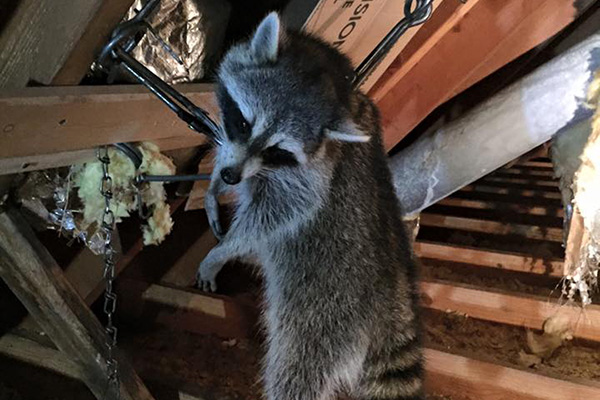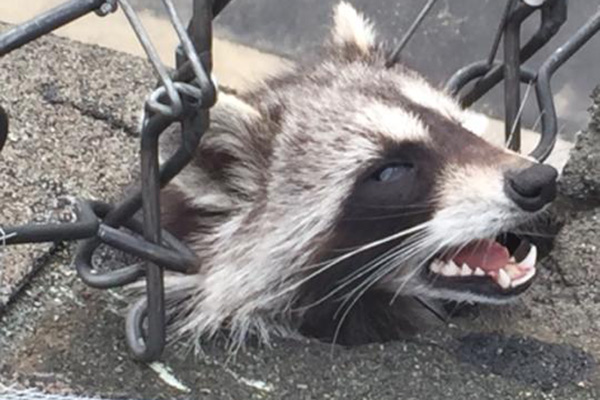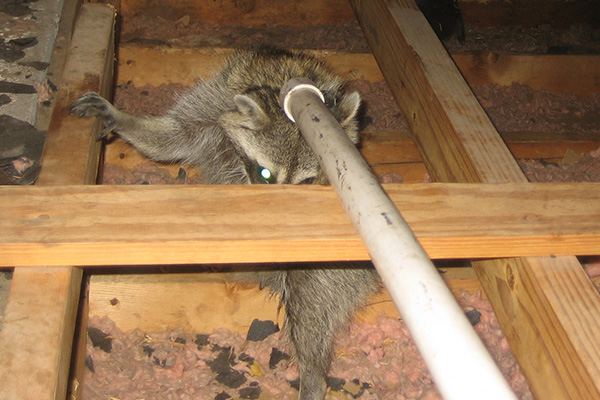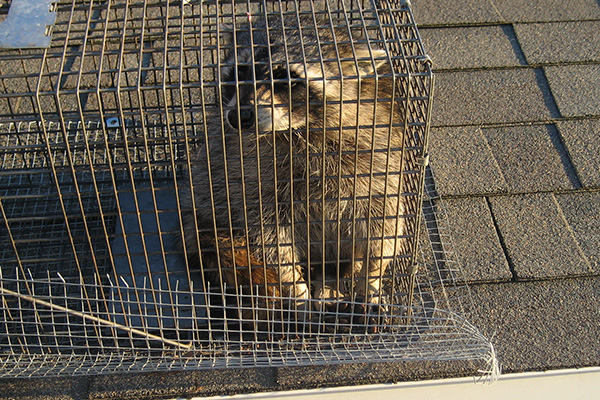- info@animalatticpest.com
- Call - we service 300 locations

How to Kill Raccoons in the Attic - Does Poison Work?
"Raccoons are just big rats with striped tails! I know how to solve the problem, just kill 'em!" Possibly, but killing raccoons is actually much more difficult than exclusion or trapping, and less effective. You could set lethal traps by the raccoon holes, but these traps are very difficult to set, not to mention dangerous. In fact, unless you're an experienced fur trapper, there's no chance you will successfully do it. What about poison then? There are no registered rodenticides for raccoons. Raccoons never eat food in an attic, so unlike with rats, they will not consume rat poison. And rat poison is not designed for raccoons, so if they did eat it, they probably won't die. Also, if you do manage to kill one with poison, the smell of a rotting raccoon is terrible. Any of these attempts are inhumane of course, if you care, which you might not if your top interest is killing them. I understand if you may hate the raccoons, or think that killing them is the logical approach and so on, but seriously, it's a lot more challenging to kill raccoons than to do a proper removal via live trapping methods. The most important thing is this: if you absolutely must kill a raccoon for some reason, please do something humane like shoot it, rather than attempt to resort to lazy and ineffective poison.
Is Killing Raccoons the Best Approach to Solve the Problem?
Body Grip Trap
This is a very dangerous and difficult trap to set. It's also simply a dumb way to do it! It's a lot better to get the young and catch the mom in a live cage trap.
Connibear at the Hole
You can set this type of trap at a raccoon entry/exit hole, but it's difficult and dangerous to set, and it only catches one raccoon at a time.
A Better Way - Snare Pole
You can remove raccoons by going into the attic with a snare pole, and noose her and put her in a trap and relocate her away from the capture site.
A Better Way - Trapping
Ah, the easiest way of all. You can set a trap at the raccoon hole, which the animal is forced into, and then relocate the animal alive.
Information About Killing Raccoons in the Attic
How To Kill Raccoons In The Attic – Does Poison Work?
For some people, the first instinct when discovering an animal in their attic is to kill it. While this will get rid of the animal in question, it is not the best option. Not only is it typically unnecessary to kill a raccoon in your attic, but it won’t solve your problem. Unless you get the raccoon out of your home AND seal up every entry point, more will just come inside. Even so, you will have to figure out how to safely dispose of the dead animal and be killing an animal that didn’t have to die. If even knowing that there are better options, you still want to know how to kill raccoons in the attic, there are a few options.
Poison Is Ineffective
The go to option for many people when it comes to killing animals is poison since you can be removed from the situation. You just leave the poison out and don’t have to watch the raccoon die. The bad news for those interested in using poison to kill a raccoon is that it will not work. If the poison does manage to kill the animal, you still have to find it and then dispose of it. In most cases, the raccoon will retreat to a cozy hiding spot to die, leaving you to search your entire attic for it later. It can also be a problem if the raccoon leaves the attic to search for food right after eating the poison. In this case, another animal will probably come by and eat the raccoon, spreading the poison through the ecosystem. To make matters worse, poison guarantees a slow and painful death for the raccoon. Of course, you are also unlikely to successfully poison the raccoon since there is no guarantee they will actually consume it.
Lethal Grip Traps Are Dangerous
Lethal grip traps are the type used by old-time fur trappers and have a long list of disadvantages. You will have to look hard to find one and buy it. They also require a great deal of experience to set up because they can easily be set off and seriously injure you. If you manage to set up the trap correctly, what happens if another animal gets into your attic, like a cat? The trap won’t discriminate and will kill anything that steps on it. Of course, you also need a license to trap raccoons in most states and lethal grip traps are outlawed nearly everywhere so this would be an illegal option.
Shooting Or Using A Knife Is Impractical
If you are a licensed gun owner and a good shot, you could theoretically bring your gun up to the attic and shoot the raccoon. Of course, if you miss, you will end up with bullet holes in your attic that need to be fixed and either way, you will have to deal with some concerned neighbors asking about the noise. There is also the issue of messiness since shooting tends to create blood splatters you would then have to clean up. If you don’t kill the raccoon with a single shot, this would also be inhumane as the raccoon will die a slow death as it bleeds out, suffering. You can also try to use a sword or knife to kill the raccoon, but almost no one will manage to do this.
Killing The Raccoon After Trapping
Some people think about trapping the raccoon and then killing it. As mentioned above, many areas of the country make it illegal to trap raccoons or other wildlife without a specific license, so this may or may not be legal in your area. Assuming it is legal, you have a few main options for killing the raccoon, other than a knife or shooting it as mentioned above. Drowning the raccoon is inhumane and fairly impractical. The two good methods of killing a trapped raccoon are a carbon dioxide chamber or a lethal injection, either of which will give the animal a quick and painless death. Of course, first you would need access to these things.
Alternatives To Killing
Since killing raccoons in the attic is impractical and inhumane no matter how you plan on doing it, you may be wondering what you should do instead. The best and simplest option is exclusion. This involves sealing every hole leading into your attic except the one the animals use most often. Place a one-way door over this entrance and wait for the animals to leave. You can also use a live cage trap to get the raccoons and then relocate them depending on your local regulations. In many areas, only licensed wildlife professionals can legally relocate raccoons so you might need to hire one. To make catching the raccoons easier, professionals may also place a repeater trap outside the entrance to the attic where you would put the one-way door. When it comes down to it, you are more likely to see a resolution to your raccoon problem with some help from wildlife experts than by trying to kill the animal yourself.
The Bottom Line
How to kill raccoons in the attic - no matter how much you may hate raccoons, it's a heck of a lot easier and more effective to just do a proper raccoon exclusion. You have the added benefit of not having to deal with raccoon carcasses or rotting raccoon odor in your house. The most important thing is this: if you absolutely must kill a raccoon for some reason, please do something humane like shoot it, rather than attempt to resort to lazy and ineffective poison.




